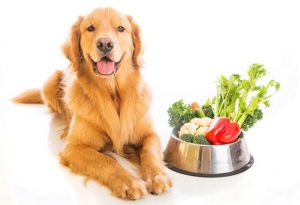
Written by Dr. Karen Shaw Becker
The canine ancestral diet contains only minimal amounts of fiber or “roughage” (about 4%). When thinking about the need for fiber in your dog’s diet, it’s important to remember that wild canines have no physiologic requirement for the plant fibers used in most processed pet food. These are typically inexpensive and include beet pulp, buckwheat and other grain hulls, flaxseed, fruit pectin, guar gum, oat and other brans, peanut shells, powdered cellulose (sawdust), psyllium and tomato pomace.
The fiber wild dogs ingest is primarily derived from the already digested stomach contents of their prey, plus fur, tendons and ligaments, along with occasional nibbles of grasses and other plant material. So, while your dog doesn’t need the absurd amounts of cheap fibers and starches found in most processed pet foods, he does need some fiber to be optimally healthy.
Why Your Dog’s Digestive System Needs Fiber to Function Properly
Dietary fiber can be generally defined as complex carbohydrates that are resistant to the digestive enzymes produced by an animal’s gastrointestinal (GI) tract. The primary source of fiber for today’s dogs comes from plants, since most no longer hunt and eat prey animals.
Though fiber is indigestible and has little or no nutrient value, it does play an important role in your dog’s digestive process, including helping to maintain microbiome health and diversity. The presence and type of fiber in the digestive tract determines how fast food passes through. Depending on the type of fiber, it can either speed up the process or slow it down.
Fiber increases bulk and water in the intestinal contents. It can slow down the rate at which food passes through the digestive tract in animals with too-fast transit times, and it can speed up the process in animals with slow transit times. That’s why fiber benefits both diarrhea and constipation.
Some fibers are also broken down in the intestine into fatty acids, which help prevent overgrowth of unfriendly bacteria and maintain a healthy gut microbiome. Fiber allows time for nutrients and water to pass from the large intestine into the bloodstream, and it also binds certain toxins in the gut and removes them from the body in feces.
Types of Fiber
Fiber is either soluble or insoluble. Soluble fiber dissolves in water and is more digestible than insoluble fiber. Soluble fiber promotes smooth passage of food to the GI tract, while insoluble fiber speeds up the rate at which food passes through. Examples of soluble fiber (some of which aren’t appropriate for dogs) include:
| Oats | Root vegetables |
| Barley | Root tubers |
| Rye | Psyllium husk |
| Certain types of legumes | Flaxseeds |
| Some fruits and veggies | Nuts |
Insoluble fiber sources (some of which aren’t dog-friendly) include:
| Whole grain foods | Cauliflower |
| Wheat and corn bran | Zucchini |
| Lignans | Skin of potatoes |
| Beans | Some fruits (e.g., avocado) |
| Peas | Skin of some fruits (e.g., kiwifruit, tomatoes) |
| Green beans | Some nuts and seeds |
Fibers are also fermentable and non-fermentable. A fiber is fermentable if the bacteria in the GI tract can break it down. Fermentable fibers contain nutrients that can be turned into energy for use by an animal’s body. Soluble fibers are generally more fermentable than insoluble fibers.
Is Your Dog Eating a Fiber-Deficient Diet?
As I mentioned earlier, a small amount of fiber in your dog’s diet is very important, but a diet loaded with fiber can be extremely detrimental.
If you’re feeding a nutritionally balanced, species-appropriate diet that includes low-glycemic, fibrous vegetables and appropriate supplements (e.g., pet probiotics and digestive enzymes), and your dog is easily producing small, firm stools, she’s probably getting the amount of fiber her body needs.
Unfortunately, many veterinarians lump all raw and fresh foods into one category, which demonstrates the lack of knowledge within the veterinary community regarding fresh food diets. There are many categories of fresh foods, some more nutritious and healthier than others. It’s important vets become “fresh food literate” about the many different feeding styles under the umbrella of “fresh food diets” to be able to correctly assess their patient’s nutritional status.
Most vets, including myself, have concerns about animals eating nutritionally unbalanced, raw “prey model” diets (that contain only meat, bone and organ) for many reasons, including the lack of microbiome-building fiber. Research demonstrates that animals eating these diets having poorer microbiomes from the lack of roughage (veggies) in the diet.1
Watch this video for a more detailed discussion of how and why dogs and cats benefit from appropriate vegetable fiber supplementation.
Dogs fed processed, shelf-stable diets also very often benefit from the addition of a small amount of the right kind of fiber, which is fiber that closely mimics the gastrointestinal (GI) contents of small prey animals. I’ve also discovered that several brands of commercially available raw food diets are constipating for some dogs due to lack of fiber content.
Well-balanced commercial and home-prepared raw diets incorporate low-glycemic, fibrous veggies to meet dogs’ minimal fiber requirements. Vegetables also provide much needed antioxidants and phytonutrients not found in meat, bones and organs. Dogs eating raw diets without the right kind of vegetables can suffer nutrient deficiencies along with constipation.
KetoPet Sanctuary uses a variety of low-glycemic, high-fiber veggies to help maintain their dogs’ blood glucose and insulin at low and steady levels while providing the critical polyphenols and antioxidants needed for immune recovery. Some great choices to think about are finely chopped or minced Brussels sprouts, dark leafy greens (arugula, endive, escarole), green beans, broccoli and broccoli sprouts, asparagus, and cabbage.
How to Add Healthy Sources of Fiber to Your Dog’s Diet
If your dog could benefit from additional dietary fiber, I recommend adding one of the above veggie options to his meals — about 1 teaspoon for every 10 pounds of body weight, given once or twice a day. If that isn’t effective, try adding psyllium husk powder at 1/2 teaspoon for every 10 pounds of body weight, or coconut or organic acacia fiber at 1 teaspoon for every 10 pounds of body weight, once or twice a day.
If your dog is consistently producing narrow, loose stools, he may benefit from the addition of a soluble fiber called slippery elm bark to his food. When slippery elm combines with digestive juices, it produces a gel-like material called mucilage, which coats and soothes the GI tract and helps to firm the stool. About 1/2 teaspoon for every 10 pounds of body weight per meal should do the trick.
Additionally, canned or freshly steamed 100% pumpkin can also be very beneficial as an added fiber source, providing about 80 calories and 7 grams of soluble fiber per cup, along with 505 milligrams of potassium. About 1 teaspoon of pumpkin for every 10 pounds of body weight, mixed in with your dog’s food one to two times a day, can help alleviate both constipation and loose stools.








